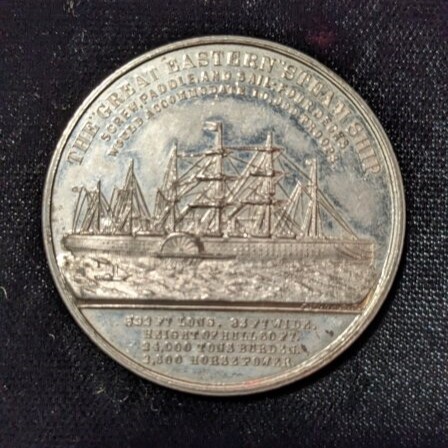This medal, struck in white metal, commemorates the death of I.K. Brunel on 15 September 1859. It features a portrait of I.K. Brunel on the obverse and an image of the SS Great Eastern, launched in 1858, on the reverse. It was produced by Joseph Davis in Birmingham, the same man who had previously produced medals for the Thames Tunnel featuring I.K. Brunel’s father, Marc. This portrait medal functions as a memorial to Brunel’s work while simultaneously promoting the wider family after his death through continued publicising of the link between Brunel’s physical image and the SS Great Eastern. This link remained a useful strategy of promotion for the family even beyond I.K. Brunel’s death, given that the Brunels to some extent transformed themselves into an engineering ‘dynasty’, with I.K. Brunel’s son Henry (1842-1903) himself taking up a career as an engineer.
The earliest portrait medals were produced for aristocratic patrons in 15th-century Italy, and were modelled explicitly on classical coinage. Such medals largely portrayed contemporary rulers or figures from classical antiquity, and were made of cast metal. By the 18th century, most portrait medals were struck rather than cast, a simpler, faster and more uniform process. The early 19th century then saw a revival of older techniques of production associated especially with Pierre-Jean David d’Angers (1788-1856) in France. This revival was arguably also assisted by a concurrent Renaissance revival across Europe. By the 1840s, the entrance of large quantities of medals to national collections (such as the medal collection of King George III bequeathed to the British Museum) reified their transformation from objects of aristocratic curiosity to artistic works of historical importance.
Between the 16th and 18th centuries, the range of individuals portrayed on medals as well as the styles of depiction diversified. Several 19th-century innovations then accelerated this expansion significantly, as medals became mass-market items on sale to a broader public. The 1836 invention of white metal enabled ‘silver’ medals to be produced much more cheaply, while the invention of the electrotype process and the reducing machine around the same time enabled faster mass production. Queen Victoria underlined this rapid progress in a diary entry detailing her visit to the Great Exhibition in 1851:
‘We likewise saw medals, made by machinery, which not more than 15 years ago were made by hand! 50 million instead of one million can be supplied a week now.’
In earlier periods, portrait medals were often pierced with a hole, or had a loop attached, in order to be hung from walls or worn on the body. By the 1800s most medals were kept flat in specially designed cabinets. They served notably as conversational stimuli for wealthy men, who discussed and debated their artistic qualities and the achievements of the individual portrayed in a process which contributed to strengthening gendered social norms. The development of mass-production techniques to some extent expanded this aristocratic pursuit, enabling the new middle classes to emulate similar activities.
Renaissance medals tend exclusively to present profile portraits, in a style derived from classical portraiture known as all’antica. Through the 19th century, portrait medals began more often to use three-quarter profiles, or front-on portraits. This portrait of I.K. Brunel is typical of 19th-century medals, presenting Brunel face on in contemporary clothing. Alongside the use of English on this medal, rather than the traditional Latin, this underlines the connection of the sitter and subject with contemporary Britain and with industrial progress.
Text (obverse): Isambard Kingdom Brunel CE F.R.S & c. B: 1806 D: 1859
Text (reverse): The Great Eastern Steam Ship. Screw, Paddle and Sail. Four Decks. Would Accommodate 10,000 troops. 692 Ft. Long, 83 Ft. Wide. Height of Hull 60 F. 24.000 Tons Burden. 2.600 Horse Power

